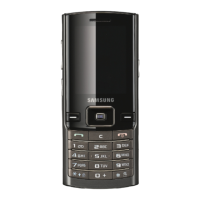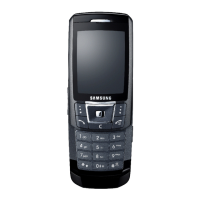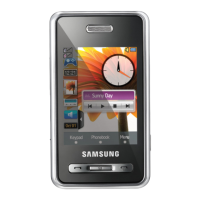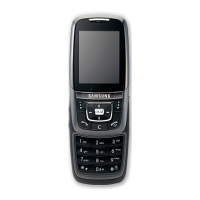Do you have a question about the Samsung SGH-D500 and is the answer not in the manual?
Illustrations showing the main elements of the phone, including earpiece, display, keys, and microphone.
Details the three areas of the display: Icons, Text/graphics area, and Soft key function indicators.
Explains the function of the display and keypad backlight and how it operates.
Details the phone's camera module for taking photos and recording videos.
Explains the use of the built-in flash for taking photos in low light conditions.
Describes how to use the plug-in speaker for louder sound output.
Step-by-step guide on how to properly insert the SIM card into the phone.
Instructions for charging the phone's rechargeable Li-ion battery using the travel adapter.
Detailed steps on how to turn the phone on and off, including password and PIN entry.
Explains how the keypad automatically locks when the phone is closed and how to unlock it.
Instructions on how to make a standard or international call and how to correct entered numbers.
How to end an ongoing phone call by pressing the end key or closing the phone.
Steps to recall and dial the most recent numbers from call logs.
How to store and dial numbers from the phone's or SIM card's Phonebook.
Method to save a number directly from the idle screen into the Phonebook.
How to adjust earpiece volume during calls and keypad tone volume in idle mode.
Steps to answer or reject an incoming call, and how to mute the ringer.
How to view a list of missed calls and access options like details and call back.
How to activate and deactivate Quiet mode to silence the phone for calls and messages.
Instructions on how to use the phone with a connected headset for calls.
Explains the role of soft keys and how their functions change based on the current screen.
Guide on how to view and select functions and options within menus using soft keys and navigation keys.
How to enter characters by pressing keys multiple times for each letter.
Method for entering words with single keystrokes using an internal dictionary.
Mode dedicated to entering numerical digits.
Mode for entering various symbols and punctuation marks.
How to switch between different text input modes using the text input mode indicator.
Detailed guide on using ABC mode, including character tables and cursor control.
Explains T9 predictive text input, including word entry and adding new words.
Instructions for entering numbers into text messages.
Guide to inserting symbols into text messages.
How to place a call on hold and switch between multiple active calls.
How to use the phone's speakerphone function during a call for hands-free operation.
How to answer an incoming call while another call is in progress.
Steps to connect and use a Bluetooth headset for calls.
How to increase microphone sensitivity for clearer voice transmission.
How to temporarily mute the phone's microphone during a call.
Options to turn key tones on or off, affecting DTMF tone transmission.
How to access the Phonebook menu during an active call for searching or storing entries.
How to send DTMF tones for automated systems like banking services.
How to view or send messages while on an active call.
Accessing additional services provided by the SIM card, like news or weather.
How to set up and manage conference calls with multiple participants.
How to split a multi-party call for a private conversation with one person.
How to remove a participant from a multi-party call.
Step-by-step guide on navigating through phone menus using scrolling.
How to quickly access menus and sub-menus using shortcut numbers.
An overview of the phone's menu structure with assigned numbers and corresponding page references.
View the 20 most recent dialled, received, or missed calls with options for details and call back.
View a list of the 20 most recent calls that have been dialled.
View a list of the 20 most recent calls that have been received.
View a list of the 20 most recent calls that were received but not answered.
Option to delete all call records at once or individually.
View call logs for made and received calls, including last call time and total time.
View the cost of calls, depending on SIM card support and network features.
Search for numbers in the Phonebook by entering names, and view contact details.
How to add new entries to the phone's or SIM card's memory, including details like name and number.
Organize Phonebook entries into caller groups for easier management.
Assign frequently used numbers to keys for quick dialing.
Create and send a personal name card via various communication methods.
Check and manage your own phone numbers registered on the SIM card.
Options for managing Phonebook memory, including default saving and copying entries.
View Service Dialling Numbers (SDN) provided by the service provider.
Enjoy Java games, change DNS settings, and view memory status for Java services.
Listen to music files using the phone as an MP3 player, including creating playlists.
Record voice memos of up to 1 hour and send them via various options.
Find out the time in different parts of the world and apply Daylight Savings Time.
Set alarms to ring at specific times, with options for auto power on.
Use the phone as a basic calculator for arithmetic operations.
Perform currency and other unit conversions using the phone.
Set a countdown timer with an alarm notification when the time expires.
Measure elapsed time for sports with stopwatch functionality.
Access additional services if your SIM card supports SIM AT functionality.
Connect to the network and load the homepage of the Wireless Web service provider.
Store and manage URL addresses of up to 15 favorite web sites.
Manually enter a URL address to access a specific website.
Clear the phone's temporary memory storing recently accessed web pages.
Configure up to 5 servers for the WAP browser, including profile, bearer, and proxy settings.
Send and receive SMS and EMS messages, including pictures and melodies.
Send and receive MMS messages containing images, video clips, audio clips, and text.
Send and receive email messages directly using your phone.
Receive and access messages from the WAP server.
Access your voice mailbox to listen to messages and change the server number.
Preset up to 10 frequently used messages for quick sending.
Receive text messages on various topics like weather or traffic.
View memory status for text, multimedia, email, or push messages.
View photos taken with the phone and images downloaded from the web or received in messages.
View recorded or downloaded video clips, and use various options for playback and sending.
Listen to music files downloaded or imported, and play them using the MP3 player.
View sound files recorded or downloaded, and use them as ring tones or caller melodies.
Check total and used memory for media items in each media box.
Consult the calendar, check events, write memos, and set reminders.
View calendar entries for the selected week in seven day boxes.
Schedule new events for the current day and view future events.
View and manage schedule events, including options for editing, sending, and deleting.
View and manage created anniversaries, with options for editing, sending, and deleting.
View and manage miscellaneous events created in the organiser.
View and manage tasks, including status marks and completion check.
View a list of missed alarm events and access corresponding event details.
Create and view memos, with options for editing, creating new, and deleting memos.
Check total memory for the calendar and the number of events stored.
Instructions on how to take photos using the phone's camera module, including image adjustments.
How to record videos using the phone's camera, save them, and play them back.
View photos taken with the phone, with options for sending, editing, and setting as wallpaper.
View photos moved from the Photos folder to the My photos image box.
View recorded video clips, with playback options and sending capabilities.
View video clips moved from the Video clips folder to the My video clips image box.
Change the current time and date, including AM/PM, time format, and date format.
Customize phone features like language, greeting message, slide settings, shortcuts, and extra settings.
Change display settings such as wallpaper, text display, skin, LCD brightness, and backlight.
Customize various sound settings for incoming calls, keypad tones, and message tones.
Access network services like call diverting, call barring, call waiting, network selection, and caller ID.
Connect wirelessly using Bluetooth or IrDA port for data transfer.
Restrict phone use with PIN check, phone lock, change password, privacy settings, SIM lock, and FDN mode.
Reset phone settings to default values, including individual menus or all settings at once.
Troubleshooting common messages like 'Insert SIM card', 'Phone locked', 'Enter PIN', and 'Enter PUK'.
Troubleshoot network connection issues and subscription problems.
Troubleshoot issues with dialing numbers, including checking network and call barring.
Troubleshoot reasons why callers cannot reach you, like phone status or call barring.
Troubleshoot issues where the correspondent cannot hear you speak, checking microphone status.
Identify and resolve low battery issues, suggesting recharging.
Troubleshoot poor call audio quality by checking signal strength and positioning.
Troubleshoot issues with dialing recalled contacts, suggesting checking and re-storing entries.
Details the phone password for security and its activation/change procedures.
Explanation of the Personal Identification Number (PIN) for SIM card security and its management.
Information on the PIN Unblocking Key (PUK) required to re-enable a disabled PIN.
Explanation of PIN2 for specific SIM card functions and its management.
Information on the PIN Unblocking Key 2 (PUK2) for changing a disabled PIN2.
Details the barring password for Call Barring function and how to obtain/change it.
Details the phone's compliance with EU requirements for radio wave exposure (SAR limits).
Guidelines for safe and proper use and handling of phone batteries.
Advises on responsible phone use while driving and adherence to traffic regulations.
Guidelines for safe phone operation in various environments and with other devices.
Information about potential interference with other electronic equipment.
Recommendations for users with pacemakers to avoid potential interference with the device.
Information on potential interference between digital phones and hearing aids.
Advice on checking medical device shielding and switching off phone in healthcare facilities.
Information on RF signals affecting vehicle electronic systems and consulting manufacturers.
Instruction to switch off phone in areas with posted notices requiring it.
Safety guidelines for operating the phone in potentially explosive atmospheres and refueling stations.
How to make an emergency call, including requirements and important considerations during the call.
Covers vehicle installation, flammable materials, air bag safety, and aircraft usage regulations.
Ability to restrict outgoing and incoming calls.
Ability to reroute calls to another number.
Ability to put a call on standby while making or answering another call.
Notification of an incoming call when engaged on another call.
Services to view or block the telephone numbers of callers.
Adaptation of SMS for sending/receiving ring tones, logos, and simple media.
Non-voice service for sending/receiving data across mobile networks, providing continuous internet connection.
International standard for cellular communication, ensuring compatibility across networks.
Programming language for applications, used for MIDlets on mobile phones.
Service for sending/receiving multimedia messages with text, images, audio, and video.
Ability to establish a conference call involving up to five additional parties.
Security code to unlock the phone when locked automatically.
Security code protecting SIM card against unauthorized use, supplied by service provider.
Intermediary server between web client and web server, improving performance by caching.
Security code to unlock phone when incorrect PIN entered three times.
Use of the phone outside your home area, such as when travelling.
Telephone numbers for special services like voice mail, directory inquiries, and emergency services.
Card containing information required to operate the phone, fitting into a slot on the back.
Network service for sending and receiving text messages without speaking to the correspondent.
Two keys whose functions vary by context, indicated on the display.
Ability to handle GSM 900, 1800, and 1900 MHz bands for better call success and roaming.
Character coding system supporting diverse languages for data transmission without corruption.
Automated answering service that answers calls, plays greetings, and records messages.
Quick steps for accessing main menu functions, including navigation and selection.
How to turn the phone on and off by pressing and holding the power key.
Steps to enter a number and initiate a call.
How to end a call by briefly pressing the end key.
How to view missed calls by opening the phone and pressing the View soft key.
How to answer an incoming call by opening the phone or pressing the key.
How to adjust the volume using the volume keys on the left side of the phone.
Instructions for storing numbers in the phone's memory or on the SIM card.
Steps to take a photo using the camera, including accessing the MP3 player menu.
How to play MP3 files by accessing the MP3 player menu and pressing the key.
| Brand | Samsung |
|---|---|
| Model | SGH-D500 |
| Category | Cell Phone |
| Language | English |











